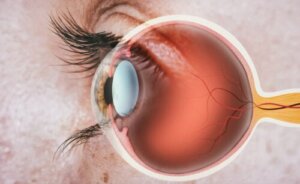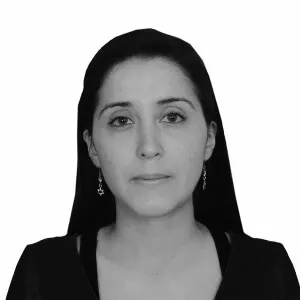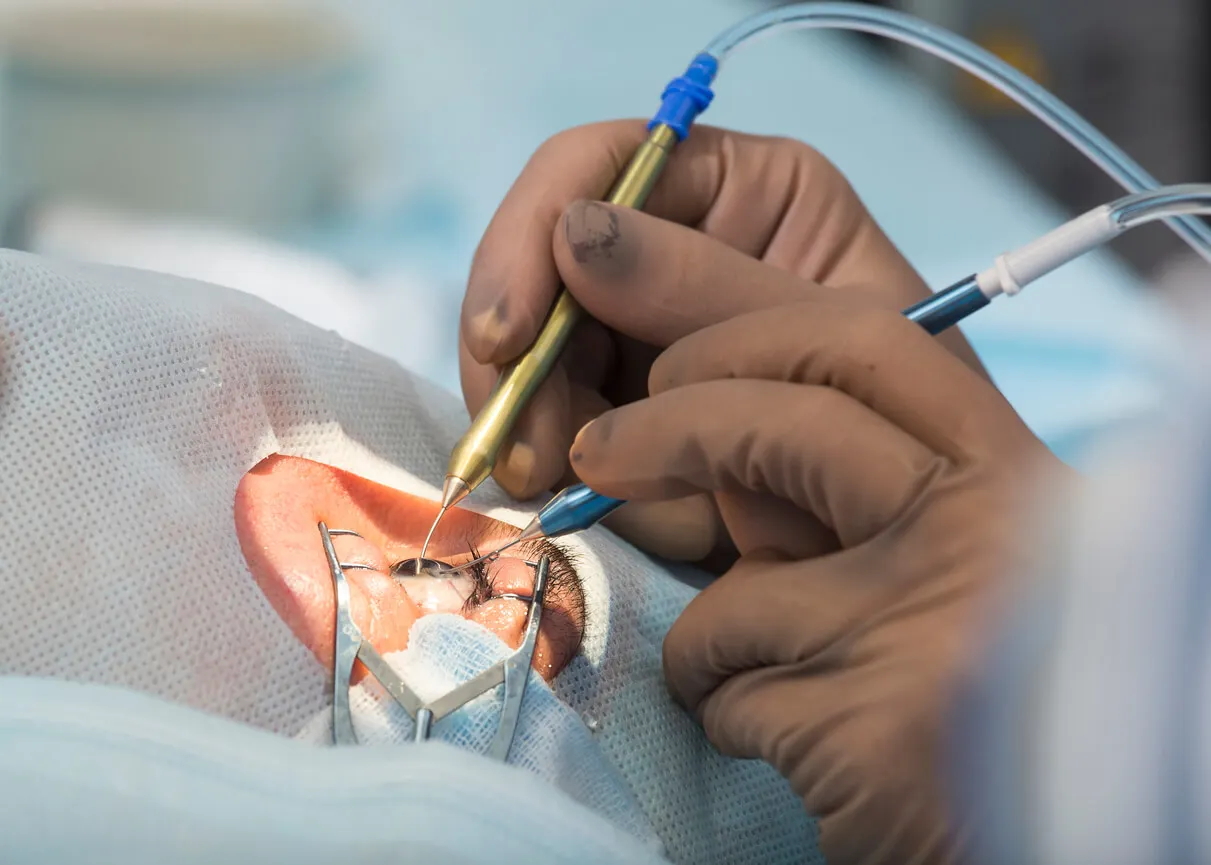What Is Aphakia and How Is It Treated?


Written and verified by the doctor Maryel Alvarado Nieto
The crystalline lens is a transparent structure in the eye that serves as a lens, allowing light rays to enter and hit the retina to focus images. Aphakia is the medical term for the absence of a crystalline lens.
There are several causes for this structure to be absent in the eye. The most frequent is secondary to removal due to the presence of cataracts.
Congenital aphakia is a very rare condition that’s often associated with other structural alterations in the newborn’s eye. That’s why a general inspection of the eyes at birth is necessary to detect any problem. It could mean a visual limitation or even blindness for the rest of a person’s life.
The function of the ocular lens
The transparency of the lens is essential to allow light to enter the eye. So, its main function is accommodation.
This last term refers to the ability of the lens to change shape depending on the visual need. Thus, it’s possible to focus light beams on the retina.
The lens adopts an almost spherical shape for near vision and a semi-flat one to observe objects in the distance.
In the case of aphakia, since the lens is absent, accommodation is not possible, and light rays enter without a focus. This results in altered and blurred vision, which, depending on whether the condition affects one or both eyes, may also be connected with other optical problems.
What are the causes of aphakia?
Alterations in the induction of lens precursor structures during a baby’s development in the womb are rare causes of aphakia. These children usually have other ocular defects, such as aniridia or the absence of an iris.
In contrast, the most common cause of aphakia in adults is cataract surgery. The opaque crystalline lens is removed to avoid visual limitations.
Cataract correction: The main cause of aphakia
Cataracts are opacities that appear in the crystalline lens, limiting the entry of light to the retina. These opaque spots can affect one or both eyes, and their location in the lens varies.
Although there are multiple causes, in a newborn, they’re usually a side effect of maternal infections during pregnancy. Similarly, genetic alterations and chromosomal abnormalities are also possible causes.
In contrast, in the elderly, lens opacities appear as a result of the aging process. Other causes of cataracts, both in children and adults, may be traumatic (an injury), metabolic, or drug-related (corticosteroids) origin. Also, aphakic vision can be the result of lens dislocation or dislocation.

Treatment options for aphakia
The goal of aphakia correction is to replace the missing natural lens with an artificial one. Although intraocular lenses (IOLs) are usually the most logical choice, their usefulness depends on the age of the patient.
In adults, this is the ideal treatment in most cases. However, in children, other considerations should be taken into account.
Eyeglasses
Bifocal lenses continue to be useful in the correction of aphakia, especially in the case of pediatric patients with bilateral involvement. In children under two years of age, the choice is usually monofocal spectacles. After that age, bifocal segments are added to improve their distance vision.
Air lenses are an attractive option for parents who don’t feel comfortable handling contact lenses in their children.
The real advantages of spectacles are that they’re less expensive than contact lenses and provide protection from ultraviolet (UV) rays. In fact, there are some materials that darken in the presence of light, having the added benefit of minimizing light sensitivity.
However, they’re thick and heavy, so they’re often considered a not very attractive option. Likewise, since they tend to magnify images, they may have a psychological and social impact on the patient.
With this type of glasses, the visual field is diminished, and objects may appear and disappear in front of the person’s eyes. In addition, they’re not useful in the case of unilateral aphakia or when the differences in magnification between the two eyes are large. This is because they don’t allow the development of binocular vision, generating amblyopia and strabismus.
We think you may be interested in reading this, too: What Colors Look Good on You According to Your Skin, Hair, and Eyes
Aphakic contact lenses
Contact lenses are a very useful resource in visual rehabilitation in patients of any age. They can also be used in cases of single-eye disease or in people with bilateral aphakia.
The main disadvantages are their high cost and the constant need for replacement due to the growth of the eye in the first years of life. Placing them can also be difficult for some parents.
Similarly, occasional lens loss is an additional problem to consider. Generally, in children with monocular aphakia, it’s recommended that the contralateral eye be occluded to avoid the development of vision disturbances.
Rigid or flexible lenses are available on the market that has demonstrated good tolerance in most people.
Similar to what happens in the case of rimmed glasses, in young children, a few diopters are often added to increase their near vision focus. Then, depending on the patient’s follow-up, the doctor may decide to move on to bifocal lenses. This usually occurs between 2 or 3 years of age.
Some parents prefer to visit every month to have the contact lenses replaced by a specialist. This is another possibility.
Like this article? You may also like to read: Dark Circles Under The Eyes in Children: A Reason For Worry?
Intraocular lenses (IOLs)
Intraocular lens implants are an attractive option for rehabilitating vision in older children and adults. In contrast, the technical problems faced by the surgeon – both in choosing the appropriate intraocular lens in young children and the high risks of subsequent complications – often make it the least viable option for these patients.
The recommended age for intraocular lenses has decreased with technological advances.
The main study that tracked the treatment of aphakia in childhood, The Infant Aphakia Treatment Study (IATS), was conducted with patients who had no other structural abnormality in the eye. Therefore, considerations in children with additional conditions should be evaluated by an experienced team.
Intraocular lens implantation doesn’t eliminate the need for spectacle frames. There are refractive changes that must be corrected after surgery, and glasses are frequently used for this.
Also, the main complications to consider with intraocular lenses are the development of glaucoma and visual axis opacification. Not to mention the surgical difficulties depending on the condition of each eye.

Follow-up: The key to success when it comes to aphakia
It’s vitally important for parents to understand that cataract surgery is only the first step in a child’s visual rehabilitation. The cooperation of adults is essential for the successful management of aphakia.
During the first years, check-ups should be regular and frequent, but follow-ups of these patients should be maintained throughout life. Some consultations should be conducted under sedation to allow a thorough examination in the case of young children.
All cited sources were thoroughly reviewed by our team to ensure their quality, reliability, currency, and validity. The bibliography of this article was considered reliable and of academic or scientific accuracy.
- Riordan, P.; Cunningham, E.; Vaughan y Asbury Oftalmología General; Capítulo 8; Decimoctava Edición; Mc Graw Hill; 2011.
- Sadler, T.; Langman Embriología Médica; Capítulo 20; Decimocuarta Edición; Wolters Kluwer; 2019.
- Sgroi, M.; Fandiño, A.; Corrección de la Afaquia en Pediatría; Medicina Infantil; 22 (2): 149 – 151; 2015.
- Baradaran, A.; Shirzadeh, E.; Eslani, M.; Akbari, M.; Optical Correction of Aphakia in Children; Journal of Opthalmic and Vision Research; 9 (1); 2014.
- The Infant Aphakia Treatment Study Group; The Infant Aphakia Treatment Study Design and Clinical Measures at Enrollment; Archives of Ophthalmology; American Medical Association; 128 (1); 2010.
- Repka, M.; Visual Rehabilitation in Pediatric Aphakia; Developments in Ophthalmology; 57: 49 – 68; 2016.
This text is provided for informational purposes only and does not replace consultation with a professional. If in doubt, consult your specialist.








